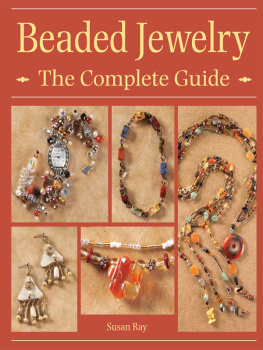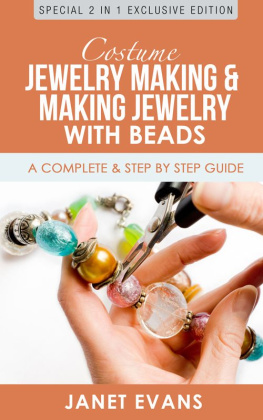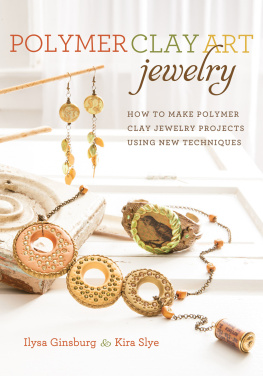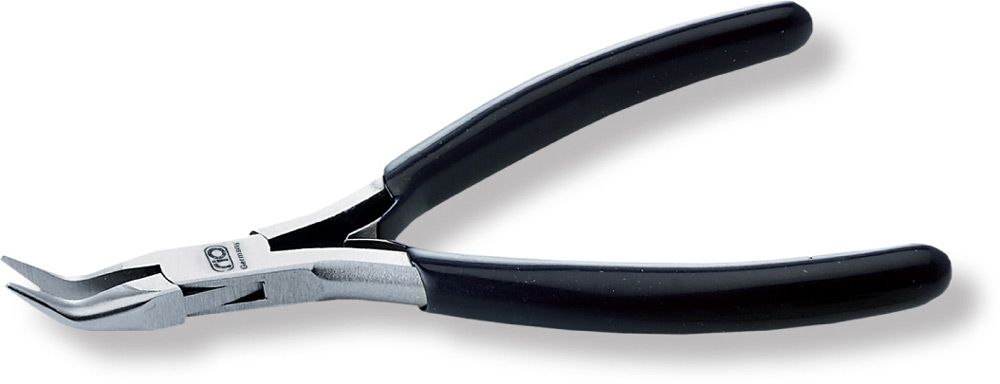The Complete Photo Guide to
JEWELRY MAKING
2nd Edition


Copyright 2010, 2014 Creative Publishing international All rights reserved. No part of this work covered by the copyrights hereon may be reproduced or used in any form or by any meansgraphic, electronic, or mechanical, including photocopying, recording, taping of information on storage and retrieval systemswithout the written permission of the publisher.
Due to differing conditions, materials, and skill levels, the publisher and various manufacturers disclaim any liability for unsatisfactory results or injury due to improper use of tools, materials, or information in this publication.
First published in the United States of America by
Creative Publishing international, a member of
Quarto Publishing Group USA Inc.
400 First Avenue North
Suite 400
Minneapolis, MN 55401
1-800-328-3895
www.creativepub.com
Visit www.Craftside.Typepad.com for a behind-the-scenes peek at our crafty world!
Digital edition published in 2014
Digital edition: 978-1-62788-008-4
Softcover edition: 978-1-58923-802-2
Library of Congress Cataloging-in-Publication data available
Copy Editor: Ellen Goldstein
Proofreaders: Kari Cornell, Karen Ruth
Book and Cover Design: Kim Winscher
Page Layout: Danielle Smith, Laurie Young
Photographs: Corean Komarec, Lightstream, Michael V. Powley, Rio Grande
CONTENTS
Introduction
Jewelry designing has become one of the most popular forms of crafting for both amateur artists and professional craftspeople. One reason for its popularity is that jewelry is a medium that can be enjoyed twice. Designers are first able to experience the pleasure of creating a jewelry piece and then have the opportunity to enjoy it again by wearing it rather than hanging it on a wall or setting it on a shelf, only to have to dust it at some point later.

No matter what your style, you will be able to find a type of jewelry that meets your needs. Plus, there are so many different methods for making jewelry it is just about impossible to master them all. This leads to broad possibilities in jewelry designing, and that is what this book is all about: visually showing, through a comprehensive guide of photographs, a variety of jewelry techniques available to all jewelry crafters. If you are a novice, youll find an assortment of jewelry techniques to help get you started. For more experienced jewelry designers, the collection of jewelry methods presented may inspire you to try a new form of jewelry construction.
Along with techniques, plenty of projects are provided to illustrate how to combine these methods into finished jewelry pieces. However, dont limit yourself on this creative journey. Try the projects, and then experiment, play, and explore as you make your own jewelry designs using any number of techniques and materials included throughout the pages of this guide.
Become inspired in the gallery of amazing jewelry designs created by an assortment of artists, beginning on . These designers have used a plethora of techniques from bead stringing to metal work and more. After viewing these gallery pages, move onto these designers web sites to see more of their creations. Then start imagining the jewelry pieces that will encompass your own distinctive perspective.
BASICS
E ven though there are specialized tools and supplies required for specific types of jewelry making, a good number are also universal for the majority of jewelry techniques. If you are new to jewelry making, use this section to gain an understanding about the most common tools and supplies that are used for this very diverse craft. If you have tried a few jewelry-making techniques and want to discover more, refer to this section when you want to brush up on what youve already learned.
General Jewelry-Making Tools
This section discusses tools that just about all jewelry designers should have in their tool boxes and includes general uses for each one as well as tips for picking a quality tool. Most of these tools are available from jewelry supply vendors, bead stores, or craft stores (see ).
CHAIN-NOSE PLIERS
This particular tool is helpful for just about every type of jewelry making, from beading to fabricating. The nose is slightly rounded on the outside but flat and untextured on the inside. Chain-nose pliers are helpful for grasping materials as well as bending and shaping. Look for a pair with a spring handle, and make sure the handle is not too long to comfortably hold. The handles can range in length, usually around 5 to 6 inches (12.7 to 15.2 cm) long.
BENT-NOSE PLIERS
These are very similar to chain-nose pliers when it comes to form and function. However, because they are angled about 45 degrees on the end, they feel more like an extension of your fingers when working with them.
FLAT-NOSE PLIERS
These are very much like chain-nose pliers. Anyone working with wire, metal, and even beads will find these helpfulthey provide an extra pair of fingers for bending material. They are most helpful when trying to make wider bends in metal than might normally be done with chain-nose pliers, but the distinction between the two pliers is marginal. The very subtle difference is in the shape of the pliers nose, which is (as the name implies) flat.
ROUND-NOSE PLIERS
The nose on these pliers is rounded like two cones, which is helpful for curling wire as well as metal plate. As for all pliers, a spring handle is preferable, and the handles should not be too large to hold comfortably. The nose should be tapered as much as possible to allow for forming tiny curls using the end of the nose.
NEEDLE FILES
In general, needle files come in a set that includes different file shapes such as flat, round, half-round, square, and triangular. They are available in different lengths, but the small ones are about 5 inches (12.7 cm) long. Needle files resemble nail files, but the grit on these is much coarser and is designed for filing down the ends of wire or rubbing out scratches on sheet metal.














